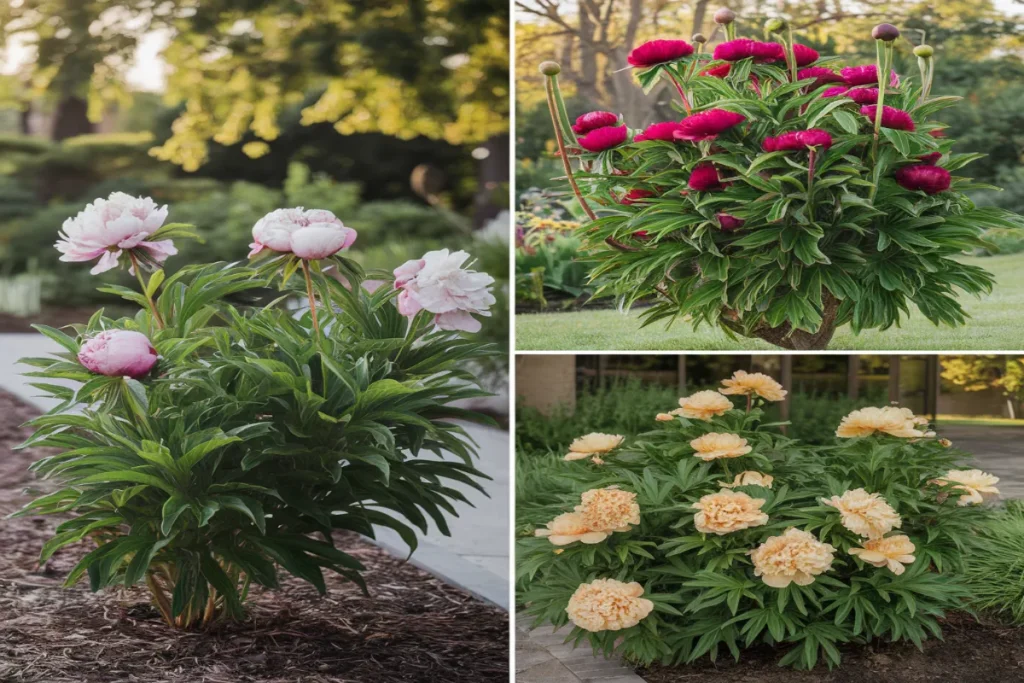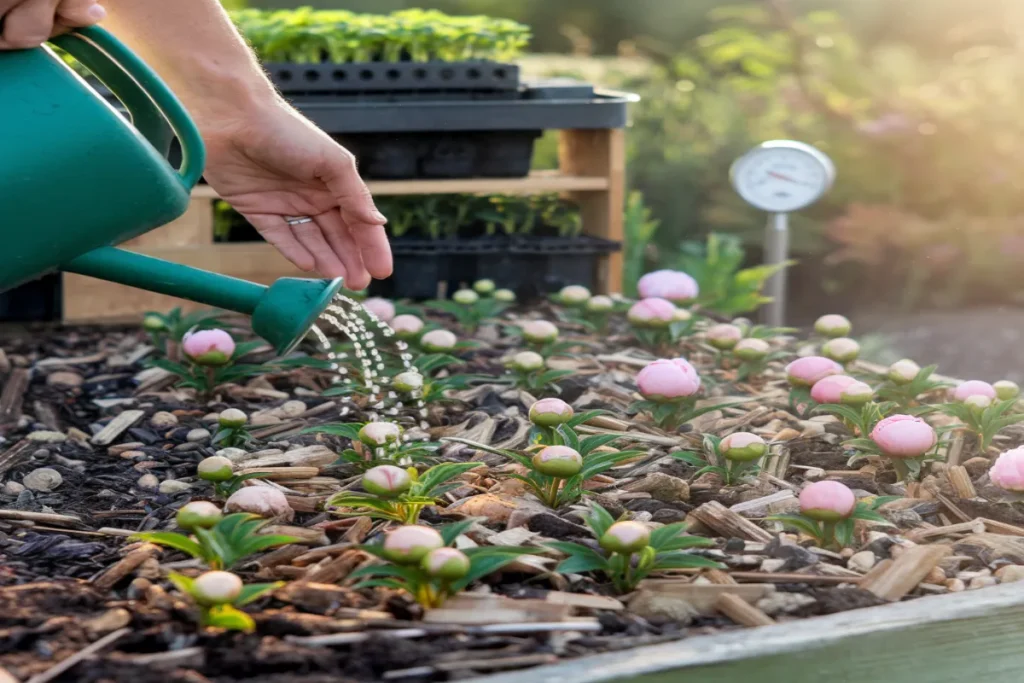In the quiet garden of the Betty Ford Alpine Gardens in Vail, Colorado, a botanist found a secret about peonies. This discovery changed how she saw these flowers. Most people love peonies for their beautiful blooms. But, few know about their hidden reproductive power.
Does peony have seeds? Yes, they do. Many peony types make seeds, with some varieties making lots of fertile seeds. If you’re wondering about seed pods, you’ll find that different peonies produce seeds in different ways.
Not all peonies are the same when it comes to seeds. Some, like intersectional hybrids, don’t make seeds. But, varieties like ‘Coral Charm’ might not have seeds that can grow. This makes learning about peony seeds a fun journey for plant lovers.
Seed picking happens in late summer, from August to September. A tree peony can make over 50 seeds per pod. This gives gardeners a chance to grow more peonies. The trick is to know which peony variety works best for you.
Table of Contents
Understanding Peony Reproduction
Peonies have a unique way of reproducing that fascinates gardeners. They use both sexual and asexual methods to keep their species alive. This is how they grow from seed.
Sexual Reproduction Insights
Yes, you can grow peonies from seed. But, there are some things to keep in mind. Sexual reproduction in peonies is complex. It leads to new varieties and genetic diversity.
- Seedling production focuses on creating new varieties
- Genetic variations come from seed propagation
- Each seedling could be a unique plant
The Pollination Process
Pollination is key for peony seed production. Bees and other pollinators move pollen between flowers. This is how genetic exchange and seed formation happen. Successful pollination is essential for growing peonies from seed.
The genetic lottery of seed propagation means each new plant could surprise you with its characteristics!
Reproduction Challenges
Growing peonies from seed comes with challenges. Seedlings can vary a lot, and germination is complex. Gardeners should be ready for:
- Extended germination periods
- Potential dormancy variations
- Slower establishment compared to division
Knowing these details helps gardeners succeed in growing peonies from seed.
Types of Peonies

Gardeners looking into peonies seeds or bulbs find many unique varieties. Each peony type has its own traits. These traits affect how you can start peonies from seed and grow these plants.
Herbaceous Peonies: The Classic Garden Variety
Herbaceous peonies are the most common in home gardens. They thrive in USDA zones 3-8. They are great for seed propagation. Expect a growth period of 5-6 years when starting from seed.
- Typically fertile and seed-producing
- Take longer to establish compared to other varieties
- Bloom around four years after planting from seed
Tree Peonies: Unique Seed-Bearing Shrubs
Tree peonies stand out with their woody stems and unique growth. How to propagate peonies from seed is a bit different with this type. A good tree peony can produce over 50 seeds per pod, making them a fascinating choice for gardeners.
- Mature more quickly when grown from seed
- Typically start blooming in their fourth year
- Some varieties have limited seed viability
Intersectional Peonies: The Sterile Hybrid
Intersectional (Itoh) peonies are a special case for seed collectors. Unlike others, these hybrids are sterile and don’t produce viable seeds. Gardeners must use other methods like division or buy established plants to grow these.
Seed production varies dramatically across peony types, making careful selection key for gardeners wanting to grow more.
Do Peonies Produce Seeds?
Gardeners often wonder about peony seed production. Peonies do produce seeds, but it’s a complex process. Getting seeds from peony flowers requires patience and careful observation.
Seed formation in peonies is fascinating. Not all peony varieties produce seeds equally. This makes seed collection unique for each gardener. Some hybrid varieties, like P. lactiflora, may not produce viable seeds due to their reproductive structures.
Seed Formation Characteristics
- Viable peony seeds are typically black in color
- Red seeds are usually unfertilized and should be discarded
- Seed pods develop mainly when flowers are not deadheaded
When learning how to get peony seeds from flower, gardeners should know several factors affect seed production:
- Successful pollination
- Plant health
- Environmental conditions
- Presence of pollinators
Timing of Seed Production
Peony seeds form in late summer to early fall. Seed pods turn from green to brown as they mature. Patience is key – peony seeds may take a year or more to germinate. Seed leaves often appear in the second year.
“Nature does not hurry, yet everything is accomplished.” – Lao Tzu
For gardeners interested in propagation, storing fresh peony seeds is best. While seeds can stay viable for many years, fresh seeds have higher success rates in growing into new plants.
How to Identify Peony Seeds
Exploring the world of peony seeds is thrilling for garden lovers. Knowing what peony seeds look like is key for collecting and growing them.
Characteristics of Peony Seeds
Peony seeds have unique features that make them stand out. So, what do peony seeds look like? They are:
- Dark purple to black in color
- Smooth and shiny surface
- Rounded or slightly oval shape
- Approximately 1/4 to 1/2 inch in size
The seed pods of peonies are also important for identifying seeds. As seeds grow, the pods change from green to dark brown. Mature pods show that seeds are ready to be picked.
When to Harvest Seeds
Timing is everything when it comes to picking peony seeds. Here are the signs to look for:
- Seed pods turn dark brown
- Pods start to open naturally
- Seeds are deep, rich black
- Seeds are plump and fully grown
“The key to successful peony seed collection is patience and careful observation.”
It’s best to harvest peony seeds in late summer or early fall. Don’t pick seeds that are red or not fully grown. These are usually not good for growing.
The Benefits of Growing Peonies from Seeds
Are you thinking about growing peonies from seeds? It’s a great choice for gardeners who love a long-term project. Growing peonies from seed can be very rewarding.
Exploring Genetic Diversity
Can you plant peony seeds and create something unique? Yes, you can! Growing peonies from seed is a fun way to discover new varieties. Each seed has the chance to grow into something special.
- Possibility of creating one-of-a-kind bloom colors
- Potential for developing more resilient plant strains
- Opportunity to experiment with different genetic combinations
Cost-Effectiveness of Seed Propagation
Want to know how to grow peonies from seed? It’s a cost-effective way to garden. The best time to plant peony seeds is in late summer or early fall.
“Patience is the gardener’s greatest virtue when growing peonies from seed.”
There are financial benefits too:
- Lower initial investment compared to purchasing mature plants
- Potential to grow multiple plants from a single seed packet
- Long-term savings for dedicated gardeners
Herbaceous peonies take 5-6 years to bloom. But the journey is worth it. Gardeners will enjoy watching their plants grow from the start.
Peony Seed Germination Process
Growing peonies from seeds needs patience and knowing their unique germination cycle. Planting peony seeds is rewarding for gardeners who are willing to put in the time. These beautiful plants are worth the effort.
Optimal Conditions for Germination
Peony seedlings need specific conditions to grow. The germination process involves a warm-cold-warm cycle. This cycle helps the seeds grow like they would in nature.
- Temperature range for seed incubation: 70°F to 80°F
- Rooting temperature: 34°F to 50°F (best at 42°F to 45°F)
- Typical incubation period: About three months
Step-by-Step Germination Guide
To germinate peony seeds, gardeners must follow a detailed process. This supports the plant’s natural growth cycle.
- Use fresh seeds for the best results
- Space seeds 1-2 inches apart in a nursery bed
- Cover with one inch of wood mulch
- Keep the soil consistently moist
| Germination Stage | Characteristics | Duration |
|---|---|---|
| First Season | A single leaf (plumule) emerges | First year |
| Root Development | Roots start growing | 60-90 days |
| First Bloom | Potential flowering starts | 3-5 years |
Pro tip for how to germinate peony seeds: Patience is key. Not all seeds will germinate at the same time. Some may take up to three years to fully emerge.
Successful peony seed germination requires understanding the plant’s natural growth rhythm and providing consistent, nurturing conditions.

Factors Affecting Peony Seed Production
Peony seed production is influenced by many things. These include the environment and the plant itself. If you want to harvest seeds from peonies, knowing what affects seed growth is key.
Climate’s Impact on Seed Formation
The climate is very important for peony seeds. The best conditions are:
- Temperature range between 60-75°F
- Consistent moisture levels
- Adequate sunlight exposure
Very hot or cold weather, or too little water, can hurt seed pod growth. Wait until seed pods are mature and slightly open before cutting them off.
Pollinator Dynamics
Pollinators like bees and butterflies are very important for seeds. Flowers that are not too full attract more of them. This helps in spreading pollen.
“The success of seed production depends on effective pollination,” says botanical experts.
Yes, you can plant peony seed pods. But, it’s important to collect and store them correctly for the best chance of success.
Flower Characteristics and Seed Yield
Peony types vary in how many seeds they produce:
- Herbaceous peonies: Produce more seeds
- Tree peonies: Make fewer seeds
- Intersectional peonies: Have a moderate amount of seeds
Knowing these differences helps gardeners get the most from their peony seed harvesting and growing efforts.
Frequently Asked Questions
How do you collect seeds from peonies?
To collect peony seeds:
Wait until late summer or early fall – Seed pods form after blooming and will turn brown and split open when ready.
Harvest the seeds – Remove the dark brown or black seeds from the pod.
Rinse and dry them – Clean off any pulp and let them air dry.
Store or plant – You can either plant them immediately or store them in a cool, dry place.
Can you grow peonies from seeds?
Yes, but it takes patience! Peony seeds need a cold stratification period (cold, moist conditions) to germinate. They can take 2-5 years to mature and start blooming. If you’re up for the wait, plant the seeds in well-draining soil in the fall, and let nature do the work!
How do peonies reproduce?
Peonies reproduce in two ways:
By seeds – Slow method, takes years to flower.
By division – The best way! Mature plants can be dug up and divided at the root in the fall to create new plants.
If you want more peonies quickly, dividing the roots is the way to go.
Should I cut the seed pods off my peonies?
Yes, if you want bigger, better blooms next year! Removing seed pods redirects energy back to the roots instead of seed production. Simply deadhead (cut off) spent flowers before seed pods develop. However, if you want to grow peonies from seed, leave some pods to mature.
What does a peony seed look like?
Peony seeds are small, round, and usually dark brown or black when mature. They look a bit like small beads or peppercorns. Immature seeds are often reddish or green.
Do peonies come from seed or bulb?
Neither! Peonies grow from thick, tuberous roots (rhizomes). They don’t have bulbs like tulips, but their roots store energy just like bulbs do. You can plant peonies from seeds or divided roots, but root divisions bloom much faster.

